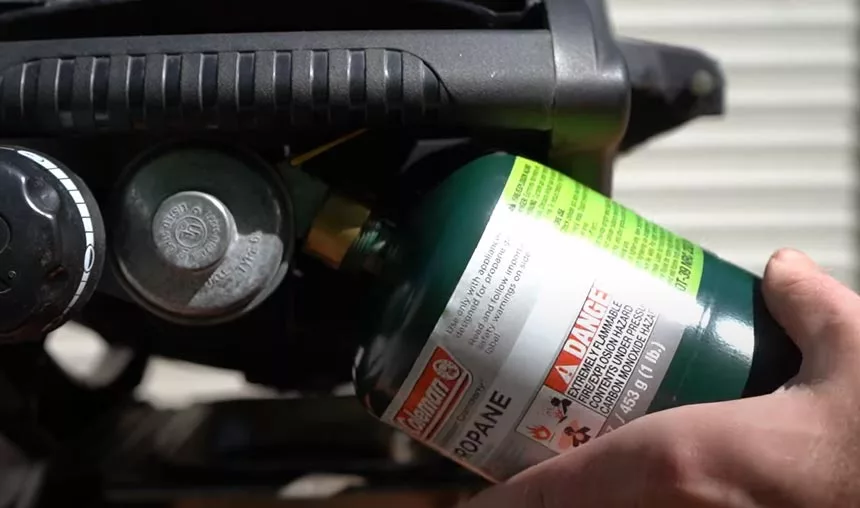Coleman is a leading manufacturer of camping gear and provides some of the best quality propane tanks. The company prides itself on its ability to fill every propane tank to exact standards. Although a primary concern that keeps consumers in a dilemma during their purchase is how long does a Coleman propane tank last?
The amount of time a propane tank will last you depends on many factors. That includes the tank’s quality and the size of the tank. For example, a smaller tank will need refills more often than a larger one.
I’ve tested multiple Coleman camp stoves, propane canisters, and tanks. It helped me better understand what size of tanks one needs, how long propane tanks last, and the amount of propane fuel to use for a refill. I have compared it all and written this article based on the results; I think that you’ll find it very useful.
Table of Contents
How Long Does a 1lb and 20lb Coleman Propane Tank Last?
Coleman propane tanks are a popular choice for campers and outdoor enthusiasts. The tanks are available in a variety of sizes, and they can be used to power a number of different devices, including grills, stoves, and lanterns, heaters. How long a Coleman propane tank lasts will depend on the size of the tank, the amount of use it gets, and the weather conditions.
Coleman provides several sizes of propane tanks to their consumers. The most common size is 16.4oz or 1lb. When going for a short camping trip, suppose one-day camping; you can readily rely on this size tank. A Standard 1lb propane tank lasts for about 2 – 2.5 hours if you use a small 7500 BTU stove with two burners on maximum flame.
The amount of propane level you’ll use on your propane stove depends on the tank size. One 20 lb propane tank is good for about 40 hours of grilling. But if you have a larger gas grill, you might need to resupply after 20 hours.
On the other hand, A 5-pound tank is only suitable for 10 hours to 12 hours of burn rate. So check your grill’s manual and calculate the hours of burn time you need to make sure you get the right size.
You can buy yourself some other sized propane cylinders as per necessity. Coleman offers their consumers a variety of sized tanks also propane bottles, including 1lb, 5lb, 11lb, and 20lb. 20lb is considered a suitable propane tank for lengthy camping trips.
What are the different types of Coleman propane tanks?
Coleman propane tanks come in a variety of sizes, including 16.4 ounces, 20-pound, 26-pound, and 30-pound tanks. The most popular size is the 20-pound tank, which is the size typically used for camping. The larger tanks are often used for home heating or cooking.
The different types of Coleman propane tanks are:
- The 16.4-ounce tank is the smallest and most portable tank. It’s perfect for camping trips or for use as a backup tank.
- The 20-pound tank is the most popular size because it’s lightweight and can be filled with enough propane to last for several days of camping.
- A 26-pound tank is a good option for those who use a lot of propane for cooking or heating because it has more fuel capacity than the 20-pound tank.
How Long Does Propane Last in A Tank?

You should know a few facts when it comes to propane gas. 1lb propane tanks contain around 22,000 BTUs. So, to calculate how long your 1lb tank will last, divide 22,000 by the number of BTUs consumed per hour by your equipment. This is a very rough calculation, and actual burn time will significantly depend on the equipment efficiency.
You can follow the same calculation procedure for determining other tanks’ lasting time. When using a 20lb tank, a medium-sized grill will need approximately 35-40 hours to run out of fuel. If you use a large grill, you may be able to cook an entire meal without refilling the tank.
How much fuel you need depends on the tank size and how hot it’s set on high. Ideally, it would be best to grill with the lid closed, using less gas. Larger gas grills burn through fuel more quickly than smaller ones. However, propane reserves are usually more than sufficient for outdoor cooking purposes.
Burn Rate for Different Propane Accessories
There are a variety of propane accessories on the market, each with different burn rates. The most common propane accessory is the portable camping stove, which has a burn rate of around 7500 BTUs per hour. Other propane accessories include heaters, lanterns, and space heaters, each with its own unique burn rates. It’s important to be aware of the burn rate of your propane accessory before you buy it, so you can be sure it will meet your needs.
How to Make Propane Tank Last Long?
During the time of long camping days, you probably wouldn’t expect your fuel tank to be empty. That could cause a significant problem for you. Whether warming up your tent or cooking meals, keeping your fuel tank filled is a crucial concern. But how to make a propane tank last long?
Well, we have brought together a few hacks in that regard. If utilized correctly, your camping days will have nothing to worry about.
- Try pre-cooking your meals at home. You can cook foods that are easy to preserve. And later on, you will just have to bring the propane tank to your camp to reheat the homemade dishes.
- Try packing the food in small portions. It will ensure less energy and time consumption while placing them over the stove for reheating.
- You can use a water heater for boiling water. That way, there will be no excess fuel burn of your propane tank.
- Try using a larger tank with a smaller gas grill, as a larger grill consumes considerably more gas for BBQ.
- To shorten the cooking time bring just add water meals for the camping trip.
- When you’re not using the heater, make sure it’s turned off.
- When you are packing your gear make sure your propane gas stove and nozzles are clean.
- Choose equipment with high burning rates (efficiency) to get the most out of your tank. To create the same quantity of BTUs, some gear burns more fuels.
- A tiny amount of propane gas is wasted when you attach a manual grill to your Coleman propane tank. Use an auto-ignition grill to avoid this.
- Reduce the temperature by 10-15% and turn off the heater when you’re not inside the tent.
How Safe Is It To Refill A Propane Tank?
Refilling a propane tank seems hazardous. However, when you choose to go with the market’s first-class seller, Coleman, you have nothing to worry about! Although I don’t recommend anyone to refill their propane tanks unless they have the proper knowledge.
In general, refilling propane tanks is safe. But there are some things you need to know. For example:
- You must use the proper gas hose. Mixing propane with anything other than air will cause leaks, explosions, and fire.
- While refilling a tank, keep it upright and make sure there’s nothing in it that could catch fire. This includes smoke detectors, pets, and flammable materials.
- Once upon a time, there was a myth that refilling a propane tank could cause massive explosions. But Coleman has introduced us to such advanced technology featured tanks with no severe risk. It’s somewhat helpful in reducing propane consumption in the environment.
- Instead of purchasing a new tank before each camping trip, consider buying an exchangeable tank. When you no longer need a tank, you can exchange it for a full one at little to no cost. Better yet, most Coleman stores’ exchangeable tanks will recycle them for you.
How To Refill Small Coleman Propane Tanks?
You may have noticed refilling a larger propane tank but not a smaller one. You can refill the smallest ones, such as a one-pound cylinder. All it requires is a couple of minutes and a few bucks. You will find many expert tank refillers available in the market. Although, if you intend to do the task yourself, I suggest you refill it in well-ventilated areas.
If you ask me which fuel to choose for refilling, it would be better to go with the Coleman fuel. With so many variants of propane fuel, I always recommend counting on the best one. It will ensure more pleasing hours of cooking time experience.
There’s some vital information to be aware of when refilling any propane supply. First, follow the instructions in the manual that came with your tank (not every propane tank can be refilled). If you are experiencing difficulty filling your propane tank, it is crucial that you ask for help.
Where to Store the Coleman propane tank?
One of the most popular questions that people have when it comes to propane tanks is where to store them. Some people choose to keep them in their basements, while others choose to keep them in their garages. The truth is, there is no one right answer to this question. It all depends on your personal preferences and the layout of your home.
If you are someone who prefers to have your tanks in a specific spot, then you may want to consider keeping them in your basement. This will ensure that they are out of the way and that you won’t have to worry about them taking up space in your garage. However, if you live in a colder climate, it’s important to make sure that your tanks are stored in a warm area, as cold temperatures can cause the gas inside the tank to freeze.
Frequently Asked Questions
There are a lot of questions to answer about propane tanks. So here are some of the most commonly asked ones:
Wrap Up
Coleman propane tanks make camping fun! With a full tank, you might be able to get through the night without freezing. But if not, there’s always the BBQ to keep you warm. The only thing that you need to remember about your Coleman tank is,
Do not place it near any object or liquid. Make sure the tank valve is always shut when you’re transporting it. If you run into problems with your propane supply, you can visit any authorized stores for support.
The Coleman propane tank information above is just a tiny fraction of what we have researched. Thanks for reading our post on how long a Coleman propane tank last and the information around them.
We hope this post helps you prepare for your next trip to the great outdoors. And if camping isn’t your thing, we also hope it improves your day-to-day life as well.




